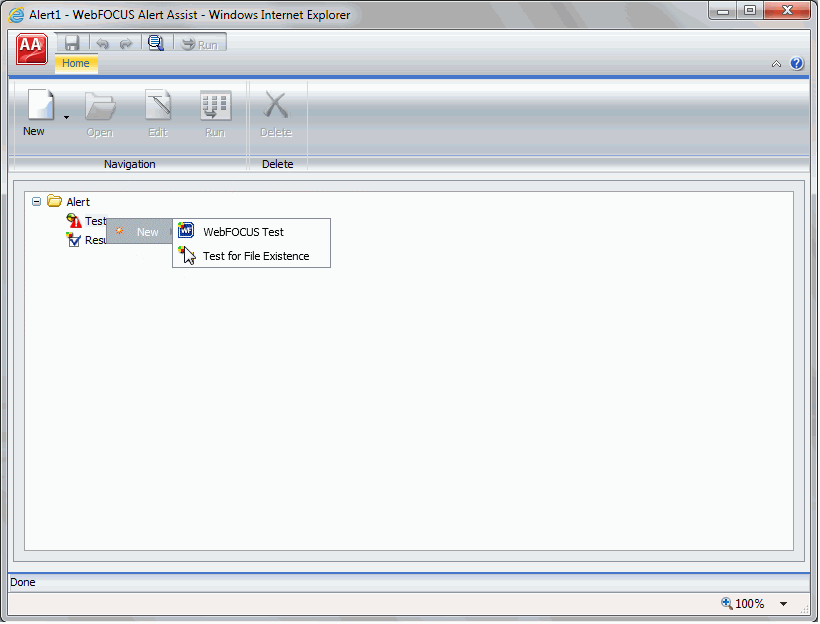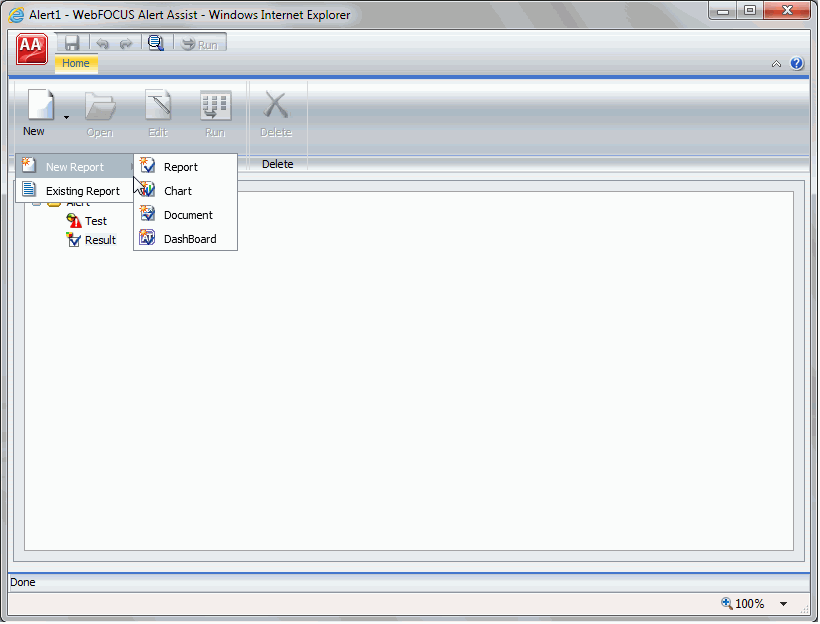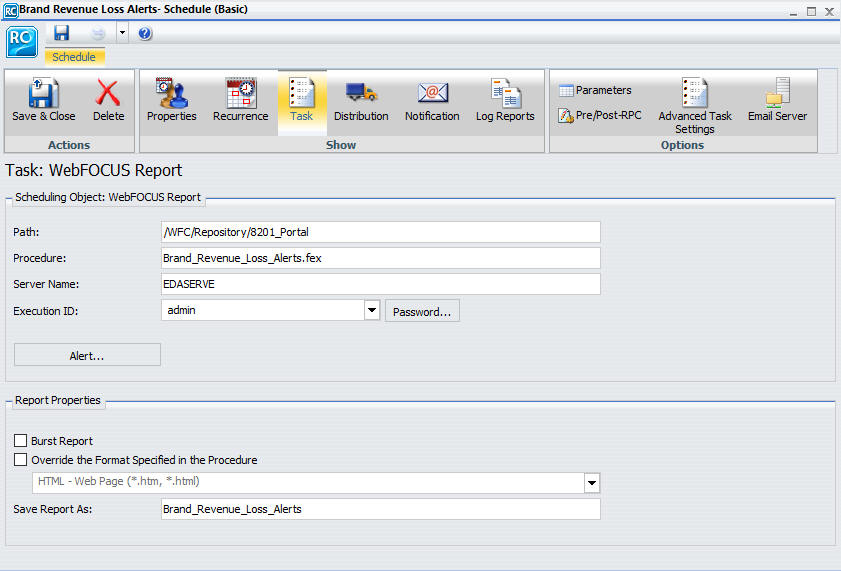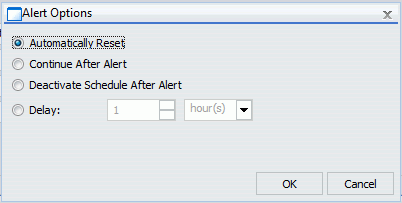Creating and Scheduling an Alert
|
How to: |
The following procedures describe how to create an Alert test, and Alert result using Alert Assist, and how to schedule an Alert with ReportCaster.
Procedure: How to Create an Alert Test
- In the
Alert Assist main window, right-click the Test node,
and then point to New, as shown in the following
image.

- Select one
of the following options:
- WebFOCUS Test. Allows you to create a new report in a scaled-down version of . Proceed to step 3.
- Test for File Existence. Allows you to select an existing report. Proceed to step 6.
Note: The scaled-down version of is used to create basic TABLE requests with HOLD (not PCHOLD FORMAT) statements. It generates procedure syntax that is written to the Alert the same way as in earlier WebFOCUS releases. The Edit option on the ribbon allows you to open the editor and manually enter the procedure code or edit existing procedure code. When the test is saved from the editor, the syntax needs to be validated as having an ON TABLE HOLD statement, a prerequisite for an Alert test.
- When you select WebFOCUS Test, opens. Select a Master File from the Open dialog box.
- Create your report as desired, and then save it.
- Close to return to Alert Assist.
- When you
select Test for File Existence, type the
full path to the file accessible to the Reporting Server that you
want to check exists. Do not use a file name or folder path that
includes spaces.
Testing a folder for existence is also valid. Type the full path to the folder accessible to the Reporting Server. If the file is located, the Alert is triggered (true) and the Alert result report is run.
- Click OK to save the Alert test.
Procedure: How to Create an Alert Result
- In the Alert
Assist main window, right-click the Result node,
and then point to New, as shown in the following
image.

- Select one
of the following options:
- New Report. Allows you to create a new report, chart, document, or dashboard, using the full version of . Proceed to step 3.
- Existing Report. Allows you to choose from the existing reports in the tree. Proceed to step 5.
- If you select New
Report, the Open dialog box opens. Select a Master File.
opens, and you can create the report that will be run when the Alert test is triggered (true).
- Save your report, and close the window to return to Alert Assist. Proceed to step 9.
- If you select Existing Report, the Open dialog box opens. Select a report you are authorized to run from the tree.
- Click Open.
The Open dialog box closes and the selected report appears under the Result node.
- Select Save from the Alert Assist menu. The Save As dialog box opens.
- Type the Alert Title, and click OK.
- Close Alert
Assist to return to the Legacy Home Page or WebFOCUS Home Page.
The Alert result is automatically run if the Alert test report is triggered (true). If you are authorized to schedule reports for distribution, you can optionally schedule the Alert.
Note: As you use Alert Assist to create reports, you may see messages that state Report Saved. Your changes to the report have been saved, but they are not written to the WebFOCUS Repository until the Alert is saved. If you exit Alert Assist before you click Save in the Alert Assist menu, the Alert is not saved.
Procedure: How to Schedule an Alert
- Access the scheduling tool in one of the following ways:
- From the WebFOCUS Home Page, on the actions bar, click Schedule
 .
.
- From the Legacy Home Page, in the Resources tree, click the domain or folder where the Alert resides. In the WebFOCUS Explorer, click the Alert and then click Schedule. Select how the Alert report will be distributed when the Alert test is triggered (true).
The ReportCaster Basic Scheduling tool opens in a new browser window, as shown in the following image.

For more information on the Basic Scheduling tool and distribution options, see the ReportCaster Guide.
- From the WebFOCUS Home Page, on the actions bar, click Schedule
- Click Alert.
The Alert Options dialog box opens, as shown in the following image.

- Select one
of the following Alert Options:
- Automatically Reset. This option continues to run the schedule at the specified time and checks to confirm that the Alert test is no longer true before the Alert test is evaluated again. It is best to use this option when you do not want to receive the Alert result again until after the exception condition has been addressed and occurs again. For example, when the quantity in inventory is greater than 20,000, the Alert is triggered. You do not want to receive the report again until after the inventory is less than or equal to 20,000 for all products and then goes back over 20,000 again.
- Continue After Alert. This option continues to run the schedule at the specified time and distribute the report each time that the Alert test is true. It is best to use this option when you want to be notified at the interval specified in the schedule that the Alert test is true.
- Deactivate Schedule After Alert. This option deactivates the schedule after the Alert is triggered. The schedule has to be activated again for the Alert test to run after the Alert is triggered. It is best to use this option for one-time Alert tests. This is the default value.
- Delay. This option is best used when you want to allow a specific period of time to address the Alert test but want to be notified again if the Alert test has not been met. You can restart the Alert after a maximum of 99 hours, days, weeks, months, or years.
As you complete the creation of the schedule, remember to consider the burst option to distribute specific report values, instead of the entire report. When a report is burst, the distribution information must be provided in a distribution list, distribution file, or dynamic list for email distribution and an access list for library distribution. The email and library distribution options are the most effective for Alert reports because of the push versus pull notification through email. For more information on using the burst option in ReportCaster, see the ReportCaster Guide.
- Select the Properties tab and type a title and summary for the scheduled report.
- Click Recurrence and
specify when and how often to run the schedule.
For more information on Recurrence options, see the ReportCaster Guide.
- Click Distribution and specify the destination information for where you want the report to be distributed. For more information on specifying schedule distribution information, see the ReportCaster Guide.
- If you wish to receive notifications of the Alert distribution, click Notification and specify the destination information for where you want the notification to be sent.
- If your Alert uses parameters, check Parameters to review and specify parameter values. Ensure that you have the correct Path, Procedure, and Server Name. For more information on specifying parameter values when scheduling a report procedure (FEX), see the ReportCaster Guide.
- Click Save and
close the ReportCaster Basic Scheduling tool.
The schedule report now appears in the repository, and you can access it from either home page.
| WebFOCUS | |
|
Feedback |